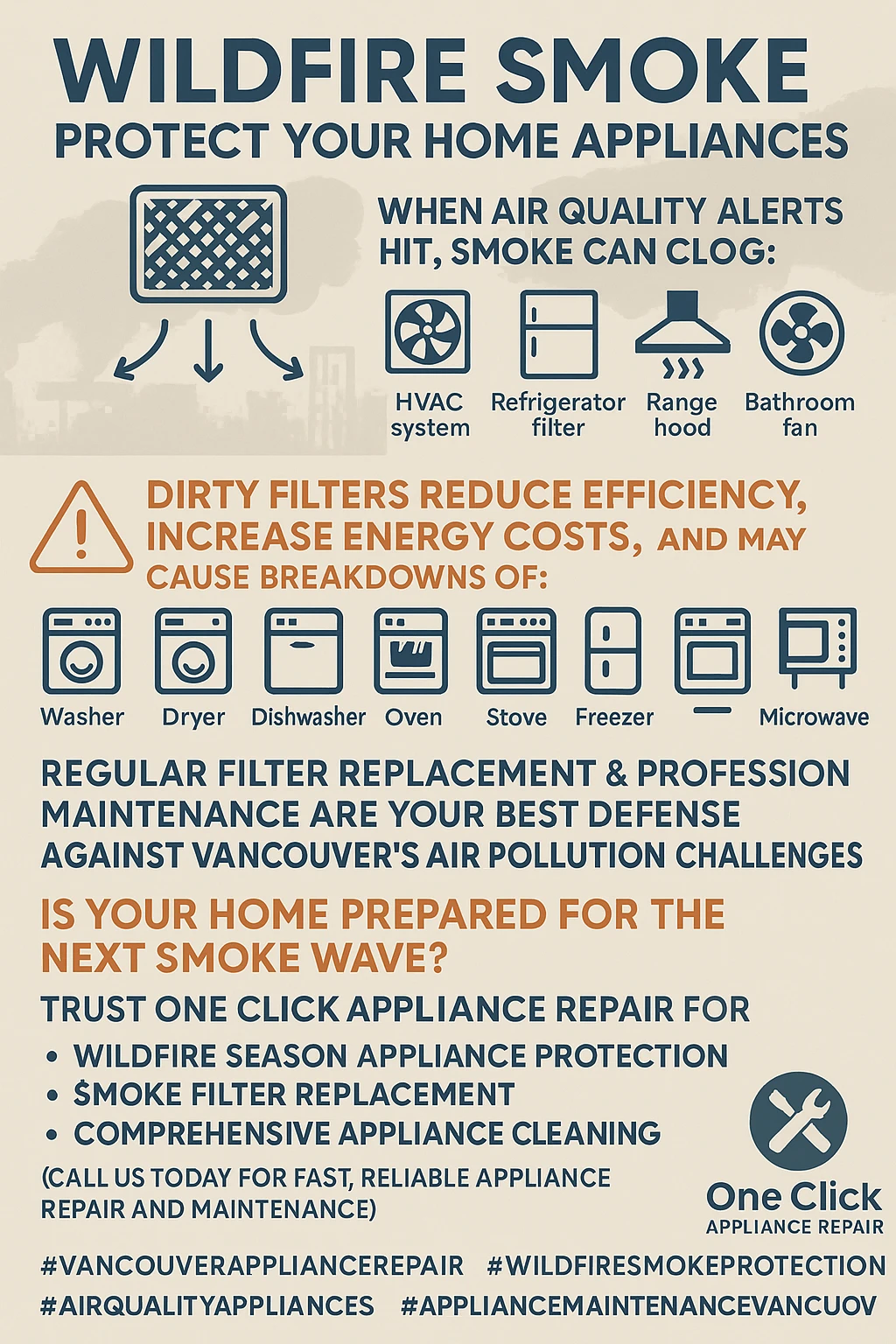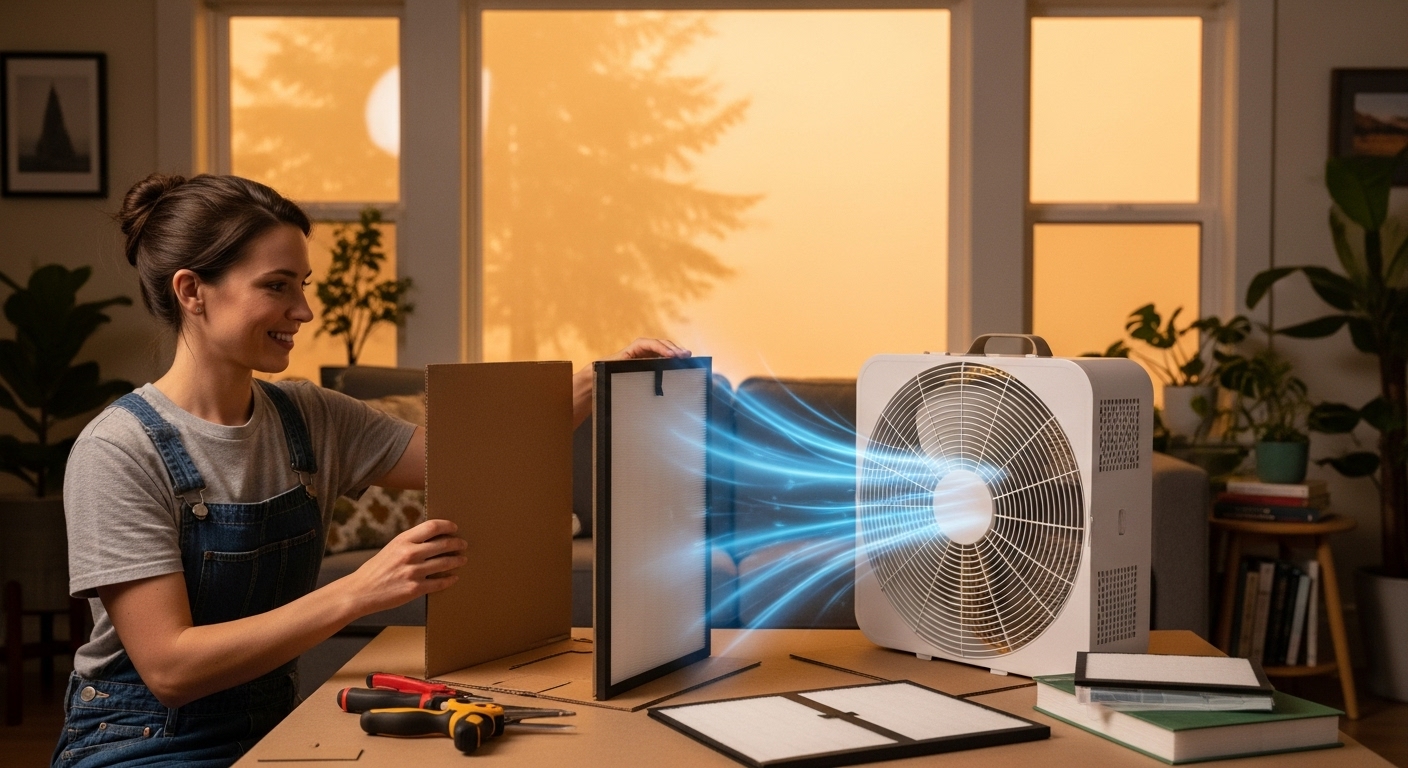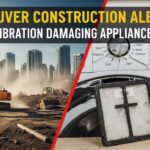Vancouver’s Wildfire Smoke Crisis: How Air Quality Alerts Are Clogging Your Home’s Air Filters and Overworking Your Appliances (Protection Strategy Inside)
Dealing with Vancouver’s increasingly smoky summers and wondering why your appliances are struggling? Here’s everything you need to know about protecting your home systems from wildfire smoke damage, plus proven strategies to keep your equipment running efficiently when air quality alerts hit the Lower Mainland.
Picture this: you wake up to another hazy Vancouver morning, check the air quality app, and see that familiar orange warning. While you’re grabbing your N95 mask and closing the windows, your home’s appliances are already under siege. The invisible enemy isn’t just affecting your lungs – it’s quietly infiltrating your HVAC system, clogging filters, and forcing every piece of equipment in your home to work overtime.
Vancouver homeowners are facing a new reality where wildfire smoke events have become an annual threat extending far beyond personal health concerns. Recent research reveals that wildfire smoke contains over 29 volatile organic compounds, including known carcinogens like benzene and acetaldehyde, that systematically infiltrate household systems and accelerate appliance deterioration. Metro Vancouver’s updated air quality warning system reflects this escalating crisis, replacing traditional advisories in 2024 to align with national terminology as smoke events become more severe and frequent across the Lower Mainland.
The most alarming discovery? Vancouver’s coastal humidity creates a perfect storm when combined with wildfire particulates. HVAC filters become noticeably clogged within just 1-2 days of moderate smoke exposure, forcing systems to work up to 40% harder while dramatically reducing efficiency. This isn’t just about higher energy bills – it’s about thousands of dollars in premature appliance replacement and repair costs that could be prevented with the right protection strategies.
Key Outtakes:
- Wildfire smoke clogs HVAC filters within 1-2 days, forcing systems to work 40% harder and increasing energy costs while reducing appliance lifespan
- Vancouver’s coastal humidity compounds smoke damage by creating corrosive conditions that accelerate appliance component deterioration beyond manufacturer expectations
- Kitchen appliances including refrigerators, dishwashers, and range hoods are particularly vulnerable to smoke infiltration, with repair costs ranging from $200-$1,200 per affected appliance
- Professional-grade MERV 13 filters can capture up to 90% of harmful PM2.5 particles from wildfire smoke, but require replacement every few days during active smoke events
- DIY air cleaning solutions using box fans and filters can achieve Clean Air Delivery Rates of 401 cubic feet per minute when properly configured

How Wildfire Smoke Systematically Damages Vancouver Home Appliances

The science behind wildfire smoke appliance damage is more complex than most homeowners realize, especially in Vancouver’s unique coastal environment. Unlike the dramatic flames you see on the news, the real threat to your home systems comes from microscopic particles and chemical compounds that infiltrate even the most well-sealed appliances.
Wildfire smoke contains PM2.5 particles – microscopic pollutants smaller than human hair that easily penetrate standard appliance filters. These particles don’t just pass through; they accumulate on internal components like evaporator coils, condenser coils, and fan blades. Over time, they form sticky residue layers that act like insulation, preventing efficient heat transfer and forcing your appliances to work exponentially harder to achieve the same results.
Recent EPA analysis identified 29 unique volatile organic compounds in smoke-contaminated environments, including seven classified as hazardous air pollutants. Among the most concerning are acetaldehyde (a probable carcinogen) and benzene (a known carcinogen) that can corrode sensitive electronic components within your appliances. These chemicals don’t just affect air quality – they create an aggressive environment that attacks metal components, wiring, and seals from the inside out.
Vancouver’s coastal location amplifies these effects in ways that catch many homeowners off guard. The city’s humidity levels frequently exceed 60% during rainy seasons, and when combined with smoke particles, create electrochemical conditions that accelerate corrosion far beyond typical wildfire damage patterns. The constant temperature fluctuations between near-freezing and mild conditions cause repeated expansion and contraction of seals and gaskets, leading to micro-cracks that allow even more smoke infiltration.
This unique “Vancouver effect” means appliances in the Lower Mainland face a triple threat: corrosive salt air, high humidity, and wildfire smoke. Research shows this combination can reduce appliance lifespans by up to 40% compared to similar units in drier climates, making protection strategies essential rather than optional for coastal homeowners.
Your Most Vulnerable Appliances During Vancouver Smoke Events

Understanding which appliances face the greatest risk during wildfire smoke events helps prioritize your protection efforts and budget. Not all home systems are created equal when it comes to smoke damage, and some present immediate safety concerns that require urgent attention.
HVAC systems bear the brunt of wildfire smoke damage because they’re designed to actively draw in outdoor air. During smoke events, your heating and cooling system essentially becomes a vacuum cleaner for harmful particles, pulling contaminated air through increasingly clogged filters. While fan component temperatures typically remain within safe operating ranges, the efficiency drop is dramatic and immediate.
Research shows that basic box fan filters achieve a Clean Air Delivery Rate of only 111 cubic feet per minute under normal conditions, but this performance degrades rapidly during smoke events. Professional-grade installations can reach 401 CADR ratings, but even these require replacement every few days during moderate smoke exposure. The constant strain on your HVAC system doesn’t just reduce filtration effectiveness – it forces motors, compressors, and other critical components to work overtime, leading to premature failure.
Kitchen appliances present unique vulnerabilities that many Vancouver homeowners overlook. Range hoods, despite being designed for ventilation, can actually introduce more contaminated air when operated during smoke events. Refrigerators suffer from compromised cooling efficiency as smoke particles accumulate on condenser coils, while dishwashers experience clogged filters, damaged heating elements, and reduced water flow as residue builds up in their intricate plumbing systems.
The laundry room creates particularly dangerous conditions during smoke events. Dryers face compound threats as smoke particles combine with lint to create enhanced fire hazards – a serious concern given that dryers cause approximately 15,500 home fires annually. Gas dryers present additional risks when smoke infiltration occurs alongside moisture from improperly vented systems, potentially leading to carbon monoxide buildup in enclosed spaces.
Single-hose portable air conditioners deserve special mention as they can actually increase smoke infiltration by creating negative pressure that draws contaminated outdoor air through building cracks and gaps. Similarly, evaporative coolers become completely counterproductive during smoke events, requiring external filter covering or complete shutdown to prevent turning your cooling system into a smoke distribution network.
Vancouver-Specific Protection Strategies That Actually Work

Protecting your appliances from wildfire smoke requires a strategic approach that accounts for Vancouver’s unique environmental challenges. Generic advice often falls short in coastal conditions, where humidity and temperature fluctuations demand specialized solutions.
The most effective protection starts with understanding the difference between professional and DIY air cleaning solutions. EPA research demonstrates that DIY air cleaners using MERV 13 filters with cardboard shrouds can achieve impressive 401 CADR ratings, while single-filter designs reach only 111 CADR. This represents professional-level performance at a fraction of the cost, making it an ideal solution for Vancouver homeowners facing annual smoke seasons.
However, successful DIY systems require specific components and construction methods. Only use newer box fans manufactured in 2012 or later, which include essential safety features like fused plugs and thermal cutoffs. Older fans lack these protections and present fire risks when run continuously during extended smoke events. The cardboard shroud design proves critical – it forces more air through the filter rather than allowing bypass around the edges.
HVAC system optimization requires immediate intervention when smoke events begin. Switch your central air system to recirculate mode rather than drawing outdoor air, and run the fan continuously during smoke events to maximize filtration. However, many Vancouver homes have systems that weren’t designed for high-efficiency filters, so verification becomes essential before upgrading to MERV 13 or higher ratings.


